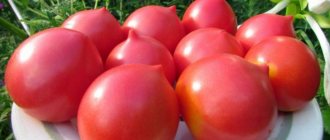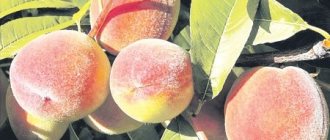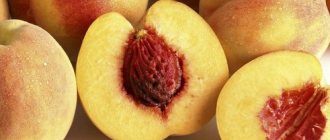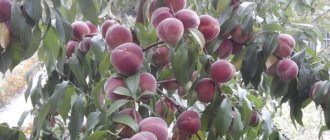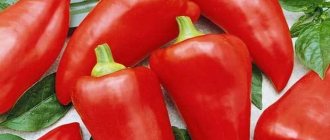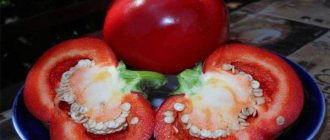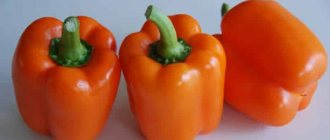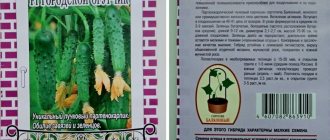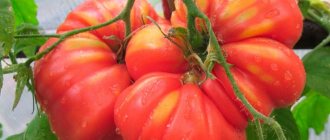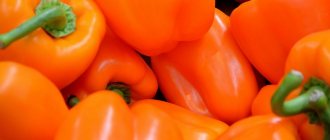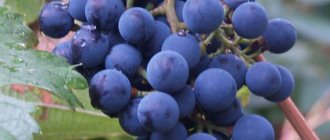History of the variety
The Redhaven peach was bred in the first half of the last century by American breeders from a state university. The main qualities of the new variety were high yield and medium-early fruit ripening.
This peach variety became the basis for the further development of subspecies and hybrids
. In particular, a little later, a hybrid with earlier fruit ripening was developed - the Early Redhaven peach.
Peach Redhaven - photo
At the end of the last century, this peach variety was included in the State Register of Russia and recommended for cultivation in the North Caucasus.
What problems do gardeners most often encounter?
According to reviews from gardeners, Redhaven is a truly productive and hardy variety. However, when cultivating it, some summer residents were faced with the need for regular treatments with chemicals to prevent diseases. This was a problem only if a person was constantly busy at work and could not devote much time to the garden. But all the costs and inconveniences were compensated a hundredfold by the harvest of tasty, aromatic and healthy fruits.
With insufficient lighting levels, Redhaven fruits do not grow very presentable in appearance, and their taste is greatly deteriorated.
Redhaven peach: description and characteristics of the variety
Peach Redhaver is a tall spreading tree with a trunk height of up to 4.8-5.0 m and a crown diameter of up to 10 m. Thick skeletal branches create a large spherical crown. All shoots are well leafed.
The bark is brown in color with a brown tint, and is very cracked. Shoots located on the sunny side have a burgundy bark color. The length of internodes is average. Vegetative buds are cone-shaped and small in size. Generative - directed towards the apex, partially pubescent.
Redhaven peach photo
The lifespan of this Redhaven peach fruit tree is 35-40 years.
. The first harvest can be harvested already in the third season from the moment the seedling is planted in a permanent place. And large harvests begin to be harvested already from the 5th season. The main thing is to plant this stone fruit crop only in regions recommended for cultivation.
The leaves are large in size, can reach 16-17 cm in length and 3.5 cm in width, dark emerald color, with a smooth, lance-shaped, elongated surface. The leaf blades are medium wavy with a clearly visible central vein. The edges of the foliage are jagged, attached to the branches with small petioles up to 1 cm long, the stipules are small.
The flowers are located singly on the branches, bell-shaped, 2.2 cm in diameter. The color of the petals is soft pink. Each bud has 5 small oval petals. The blooming buds exude a pleasant aroma, all of them are located on annual branches.
Peach Redhaven - video
Redhaven peach fruits are large, with an average weight of 130-155 g, but can weigh up to 200 g
. The shape of ripe fruits is round, slightly flattened at the edges. The stalks are small, up to 1 cm long. The peel is of medium density, slightly velvety, easily removed from ripe fruits, its color is bright orange with a burgundy “blush”. The pulp has a pleasant sweetish taste, aromatic and juicy, easily separated from the large reddish seed.
The harvested crop perfectly tolerates transportation over different distances, without losing its good presentation and taste.
. If you plan to transport the collected fruits over a long distance, then it is better to harvest 3-5 days before they are fully ripe.
Ripe fruits are stored at room temperature for only a couple of days
. If you need to store the harvested crop longer, it is better to put them in the refrigerator in special containers where the peaches can stay for a week.
Diseases and pests - prevention and control
Due to the susceptibility of the variety to a dangerous fungal disease - leaf curl - when growing it, it will not be possible to do without the use of chemical protection agents. They need to be used in a complex of preventive measures.
Table: a set of preventive measures to prevent peach diseases and pest attacks
| Deadlines | What are they doing | How they do it | Achieved effect |
| Autumn | Collect fallen leaves and burn them | Destruction of spores of pathogens and pest larvae | |
| Whiten trunks and branches with lime mortar | Preventing frostbites and sunburn | ||
| Late fall | Digging the soil | Digging the soil with a shovel bayonet and turning over the layers | Pests and pathogens that overwinter in the upper layers of the soil rise to the surface and then die from the cold |
| Early spring before buds swell | Eradication treatments | Spray the crown, branches, trunks with pesticides (DNOC, Nitrafen, 5% solution of copper sulfate) | Prevention of fungal diseases and pests |
| Spring | Preventative treatments | The crown is treated three times with fungicides (Horus, Skor, Strobi, etc.). The first time this is done before flowering, then twice more immediately after it ends with an interval of 1-1.5 weeks. | Prevention of fungal diseases |
| Summer | Treatment with biofungicide Fitosporin-M. This drug can be used without limitation on the number of times with an interval of 2-3 weeks. | ||
As a rule, such activities, carried out regularly and on time, reliably prevent the gardener from problems with any fungal diseases. No information about possible pests was found in the sources, but the above complex will help cope with them in the event of an attack.
Recent Entries
5 working ways to use tar in the garden 7 indoor plants that help you get married even in adulthood Indoor plants that can bloom in trouble
Table: description of possible diseases of the Redhaven peach
| Disease | First signs | Current and harm caused | Method of treatment |
| Leaf curl | After the young leaves bloom, pale green swellings form on their front surface. Subsequently, the color changes to bright red and brown. On the underside of the leaves, depressions appear corresponding to the tubercles. | Affected leaves turn black and fall off. The set fruits become covered with swellings and cracks, they become smaller and fall off. The number of fruit buds laid for the next season decreases sharply. | Removing affected parts of the plant and treating with fungicides |
| Powdery mildew | The appearance of a white powdery coating on leaves and fruits | Affected leaves fall off, shoots dry out, fruits crack and rot. The tree weakens and its winter hardiness decreases. | |
| Clusterosporiasis (hole spotting) | The appearance of small red-brown spots on the leaves, which quickly increase to 3-5 mm. After this, the soft tissues in them dry out and fall out, forming holes. | With significant damage, the disease spreads to shoots and fruits. The leaves fall off, the fruits crack, and cracks form on the bark. |
Photo gallery: signs of major diseases of the Redhaven peach
Leaf curl is the most dangerous peach disease
When a peach is infected with powdery mildew, a white coating appears on its leaves.
Clusterosporiosis is called hole spot because of the holes formed on the leaves as a result of the infection.
Redhaven peach: frost resistance of the variety
The Redhaven peach is characterized by a fairly high resistance to frost and, without shelter, can tolerate frosts down to -23-25 degrees Celsius.
. However, this tree does not tolerate return spring frosts very well.
The variety is also highly resistant to drought, so it can be grown in steppe regions. But this stone fruit crop reacts negatively to gusts of cold wind.
Fruit trees!
Apricot Northern triumph Plum Study Pear August dew
Reviews from gardeners
The Redhaven peach is loved by professional breeders and amateur gardeners in our country and abroad.
They leave positive reviews about this variety, noting its advantages:
- aesthetic appeal and high taste of fruits;
- excellent transportability;
- high productivity;
- leaf resistance to powdery mildew and clasterosporium blight;
- early onset of fruiting;
- high frost resistance (up to - 25°C);
- good transportability.
The variety has much fewer disadvantages. Among them, experts name the tree’s tendency to be affected by leaf curl. However, with timely detection of signs of the disease, active fight against it and regular prevention, it is possible to protect the tree from suffering and loss of productivity.
Pollinator Trees for the Redhaven Peach
Experts say the Redhaven peach is a self-pollinating variety. And although this fruit tree produces good yields without planting pollinator trees nearby, gardeners recommend planting other peach trees with similar flowering periods nearby to increase Redhaven’s yield.
The best pollinating varieties for Redhaven peach
:
- Ambassador of Peace;
- Gift of Kyiv;
- Favorite;
- In memory of Shevchenko.
Growing Requirements
The American Red Haven peach has excellent characteristics, and its cultivation is not difficult for both experienced gardeners and novice gardeners who want to have this southern fruit in their garden. This variety can be grown either by planting seedlings or from seed material in the form of peach pits.
"Redhaven" is recommended to be grown on areas that are as level as possible or with a slight elevation. When choosing a site for planting seedlings, you must remember that this heat-loving southern plant grows and develops best on medium-loamy soils with high moisture permeability and improved air exchange.
Peach trees need good lighting and should receive at least six to eight hours of direct sunlight daily. Peach seedlings are not recommended to be planted in areas where melons, garden strawberries, nightshade plants or clover were previously grown. "Redhaven" peaches should be planted on the south side of the site, in a place reliably protected from gusty north winds.
Advantages and disadvantages
The main advantages of the Redhaven peach variety include:
:
- high productivity;
- good resistance to drought and frost;
- wonderful taste of ripe peaches;
- long life span of this fruit crop;
- Ability to withstand long-distance transportation well.
Among the shortcomings it should be noted
:
- low resistance to some diseases;
- it is necessary to form the number of fruits so that the shoots do not break under their weight.
Productivity, collection and storage
The Redhaven peach is characterized by high productivity: after 5 years the tree can produce almost 45 kilograms of peaches. In another 5 years, the yield of this variety will reach 100 kilograms per year.
Due to the non-simultaneous ripening of fruits, the harvest is harvested in several passes, over the course of about a month. Appetizing peaches do not become deformed during transportation and are stored well for a month. The fruits have a universal purpose: they can be eaten fresh, canned, and made into compotes, juices, and jams.
Redhaven peach: planting and growing
It is recommended to plant the Redhaven peach in a permanent place in the second or third ten days of April, when the night temperature does not fall below +15 degrees Celsius, and the soil is already sufficiently warmed up
. In this case, the seedlings quickly adapt to the new location and begin to grow.
The area where this peach variety is planned to be planted should be illuminated by sunlight throughout the day - this is a necessary condition for the formation of a sufficient amount of sugars in the fruits. In addition, it is necessary to plant peaches in a place protected from sudden gusts of cold wind.
Important!
The soil for planting Redhaven peach on the site should be light, loose, fairly fertile, with neutral or slightly alkaline acidity. There should be no stagnation of moisture in the soil, and groundwater should not come close to the soil surface.
Planting holes should be up to 1.0 m in diameter and about 0.7 m in depth.
. If you plan to plant several trees of this variety, then a distance of 3.5-4.0 m is made between the planting holes.
A layer of nutrient mixture 20-25 cm thick is laid out at the bottom of the pit.
. It should include: garden soil, humus, superphosphate and wood ash. Then 20 liters of warm water are poured into the pit.
Peach growing technology / From planting seedlings to harvesting
When the water is completely absorbed, the tree is placed in the hole, carefully straightening its roots along the diameter of the hole.
. Then fill the hole with a nutrient substrate, carefully compacting it layer by layer. The root collar should be 5-6 cm above the ground surface.
Then a near-trunk circle is formed, which in diameter should be no less than the crown of the tree
. When planting, at least 30 liters of water are poured into it. Cover the soil with a layer of mulch 4-5 cm thick on top.
How to plant correctly
To get a strong and viable plant, it is recommended to carry out planting work correctly.
Selection and preparation of planting material
Seedlings should be purchased from local nurseries. Such plants are adapted to the climatic conditions of the region. At the same time, specialists carry out primary pruning of the plant, which increases its survival rate. It is best to choose seedlings 1 year old. Before planting, they should be soaked in water or a growth stimulant.
Recommendations for choosing planting dates
It is recommended to plant the plant in mid or late April. During this period, the soil has already warmed up sufficiently, and the temperature at night is at least +10-15 degrees.
Location requirements
Peach should be planted on a flat area. It is advisable to choose the south side. In this case, the place should be sufficiently illuminated. When shaded, generative buds will not appear on the plant. In this case, the fruits may be small and sour.
Peach does not tolerate drafts and strong gusts of wind well. Therefore, it is advisable to plant the tree in a protected place.
When choosing a site, it is worth considering that the plant will form a crown measuring 10 meters. Therefore, it is recommended to provide him with sufficient space.
The crop grows poorly in low-lying areas where there is accumulation of melt and rainwater. Peach will not take root in wetlands. Also, it should not be planted in acidic soil.
Further care for the Redhaven peach
Further care for Redhaven peach fruit trees consists of timely watering, fertilizing, and pruning shoots.
How to Water a Redhaven Peach
This peach variety especially needs moisture during the period of budding and ovary formation. And during the period of fruit ripening, the tree does not feel an acute lack of moisture. The norm for one-time application of water to one tree is 2 buckets of water. Experts recommend adding 10 liters of water to each tree trunk circle once every 2 weeks.
After each watering, you should loosen the soil in the tree trunk circles, while simultaneously removing weeds.
Interesting!
Rose Gloria Day climbing
Feeding Redhaven Peach Trees
Fertilizers are usually applied immediately after watering. In the spring, it is necessary to apply nitrogen-containing fertilizers or humus mixed with superphosphate during digging.
In the autumn, fertilizing containing complex mineral fertilizers is applied to the tree trunks of the Redhaven peach.
Peach Redhaven: Tree Trimming
Before buds bloom, Redhaven peach trees undergo spring pruning, during which excess and weak shoots are removed.
The most important rules for peach pruning
After three seasons, it is necessary to form the peach crown, making it cup-shaped or palmette.
